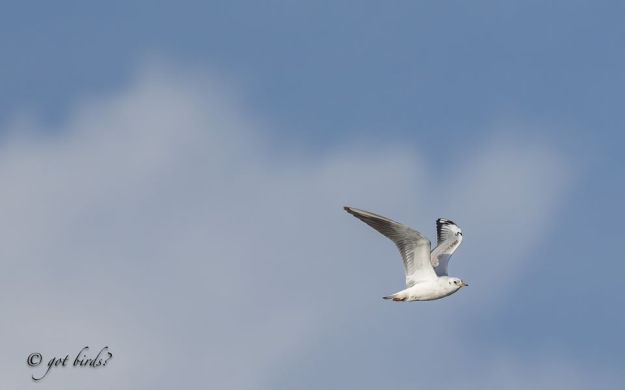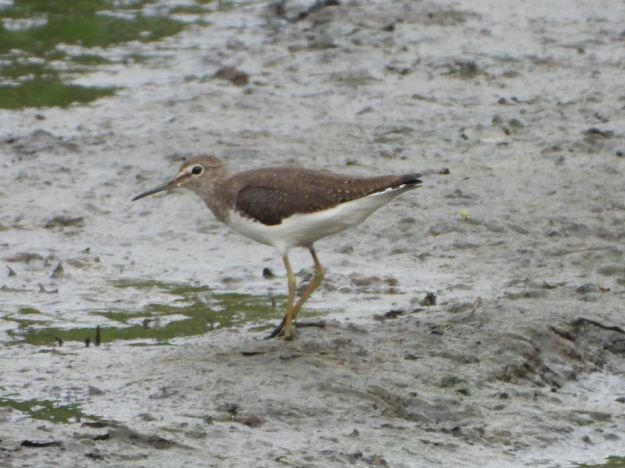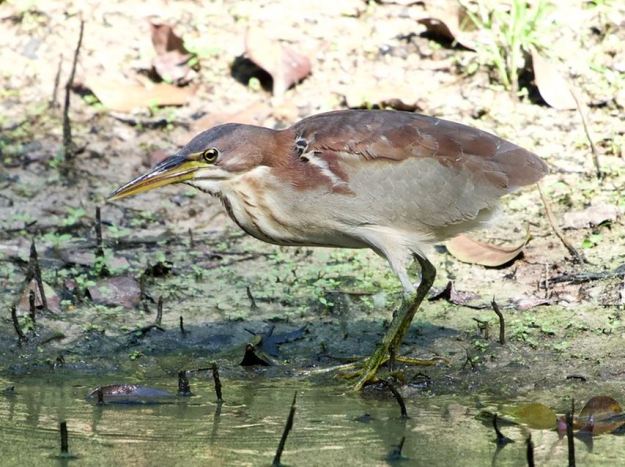By Geoff Lim & Isabelle Lee,
& Tan Gim Cheong (ed.)
February continues with unusual species – the first occurrence of the Chinese Blackbird in Singapore, the first occurrence of the nominate subspecies of the White Wagtail, and our third sighting of the very rare Chinese Blue Flycatcher.

Chinese Blue Flycatcher, photographed by a casual birder on 25 February 2020 at the CCNR.
The third sighting of the very rare Chinese Blue Flycatcher, Cyornis glaucicomans, was made by a casual birder on 25 February 2020 inside the Central Catchment Nature Reserve (CCNR). On 29 February 2020, the bird was spotted again and heard in the early morning by Geoff Lim and Isabelle Lee, and subsequently seen by several others in the late morning. Previous occurrences for the species included a sighting in November 1997 at Sungei Buloh, and a male bird photographed at Bidadari in November 2013 (the supposed occurrence in December 2015 was a mis-identification).
The Chinese Blue Flycatcher was previously lumped together as a subspecies of the Blue-throated Flycatcher, Cyornis rubeculoides, (for more taxonomic info, see Zhang, et al., 2016). Although classified as Least Concern, the bird is generally uncommon and widespread across its breeding range, which extends from southern Shaanxi and western Hubei to Yunnan, and its non-breeding range in west, central and southern Thailand, Peninsular Malaysia (del Hoyo, Collar and Christie, 2020), and Singapore.
This species prefers dense thickets, and the low and shady understorey, rarely 3m above the ground (del Hoyo, Collar and Christie, 2020); though observations by volunteers have shown that the species does visit the mid to upper canopy levels of the rainforest. In view of its preferred habitat and skulking habits, and possibility of appearances by non-breeding juvenile or female plumages, this species may be under-observed and may overwinter in Singapore.
Central Catchment Nature Reserve (CCNR) and Fringe Parks

The Orange-headed Thrush at Dairy Farm Nature Park photographed on 22 February 2020 by Alan Owyong.
The core CCNR forests yielded several good species. Apart from the Chinese Blue Flycatcher, other birds spotted include two Black-headed Bulbul, Pycnonotus atriceps, seen on 2 February 2020 at Jelutong Tower by Sandra Chia, a Blue-winged Pitta, Pitta moluccensis, on 22 February 2020 by Martin Kennewell, four Chestnut-winged Babbler, Stachyris erythroptera, seen on 23 February 2020 by Raghav Narayanswamy, and a Grey Nightjar, Caprimulgus jotaka, on 28 February 2020 by Richard Davis.
The Bukit Timah Nature Reserve (BTNR) yielded a Blue-and-white Flycatcher, Cyanoptila cyanomelana, on 15 February 2020 by Martin Kennewell, a Black-crested Bulbul, Pycnonotus flaviventris, on 21 February 2020 by Raghav Narayanswamy, who also saw two Yellow-browed Warbler, Phylloscopus inornatus, on the same day, a Malayan Night Heron, Gorsachius melanolophus, on 23 Feb 2020, by Ryan Bruce, two Cinereous Bulbul, Hemixos cinereus, and one Sakhalin Leaf Warbler, Phylloscopus borealoides, on 23 February 2020 by Lim Kim Chuah.
Over at the nearby Hindhede Nature Park, two Oriental Darter, Anhinga melanogaster, were reported by Norhafiani Majid at the quarry pool, as was a Blue-eared Kingfisher, Alcedo meninting, on 25 February 2020 by Richard Davis. On the same day, one Orange-headed Thrush, Geokichla citrina, was seen by Lu Kiat.
Dairy Farm Nature Park (DFNP) yielded a Green-backed Flycatcher, Ficedula elisae, which was spotted on 11 February 2020 by Art Toh, and on 25 February 2020 by Richard Davis. An Orange-headed Thrush, Geokichla citrina, in partial moult was observed on 15 and 23 February 2020 by Geoff Lim, who also spotted another Green-backed Flycatcher together with Yong Ding Li on the latter date. On 12 February 2020, a Crested Serpent Eagle, Spilornis cheela, was seen by Keita Sin.

Red-legged Crake with its chick at Singapore Botanic Gardens on 7 February 2020 and photographed by Herman Phua.
The month’s record at the gardens began with the sighting of a Blue-winged Pitta, on 1 February 2020 by James Tann. A report of a Hooded Pitta, Pitta sordida, was made six days later on 7 February 2020 by Peter Bijlmakers, who saw the bird in the rainforest section of the gardens. On the same day, a Red-legged Crake, Rallina fasciata, with a chick, was spotted by Herman Phua.

A white-morph Amur/Blyth’s paradise flycatcher, on 28 February 2020, photographed by Isabelle Lee
The month’s end saw reports of an Asian Palm Swift, Cypsiurus balasiensis, on 25 February 2020 by Sandra Chia; a Von Schrenck’s Bittern, Ixobrychus eurhythmus, on 26 February 2020 by Choong YT; and the re-appearance of the Taiga Flycatcher, Ficedula albicilla, also on 26 February 2020 by Josh Spiler. The appearance of a white morph Blyth’s / Amur Paradise Flycatcher, on 28 February 2020, delighted many birders, such as Norhafiani A Majid who provided the report in social media. Interestingly, one of the long tail streamers of the paradise flycatcher was half-brown half-white! On 29 February 2020, a Hodgson’s Hawk-Cuckoo, Hierococcyx nisicolor, was reported by Felicia Tay; and Cheong Khan Hoong observed a pair of Banded Woodpeckers Chrysophlegma miniaceum mating.

Taiga Flycatcher at Singapore Botanic Gardens on 26 February 2020 photographed by Vincent Lao
Central Singapore
A Lanceolated Warbler, Locustella lanceolata, was spotted under the hedgerow near the CHIJ Toa Payoh playground on 6 February 2020 by Richard Davis, who subsequently also spotted a Chinese Hwamei, Garrulax canorus, and an Eastern Yellow Wagtail, Motacilla tschutschensis, at Toa Payoh on 12 February 2020. (Note: the Chinese Hwamei appears to be a recently escaped pet).
Northern Singapore

A Hodgson’s Hawk-Cuckoo spotted on 4 February 2020 on Coney Island by Oliver Tan.
A Hodgson’s Hawk-Cuckoo, Hierococcyx nisicolor, was spotted on 4 and 7 February 2020 on Coney Island by Oliver Tan, and again on 22 February 2020 on the same isalnd by Tan Kok Hui. A Chinese Sparrowhawk, Accipiter soloensis, was seen at Lorong Halus Wetland on 11 February 2020 by Peter Bijlmakers. On 22 February 2020, a Jerdon’s Baza, Aviceda jerdoni, and five White-shouldered Starling, Sturnia sinensis, were spotted at Lorong Halus Wetland by Lu Kiat, while a solitary Little Grebe, Tachybaptus ruficollis, was spotted on 26 February 2020 by Martin Kennewell. Other birds spotted in the north included one Black-capped Kingfisher, Halcyon pileata, on 24 February 2020 at Seletar Dam by Martin Kennewell, as well as up to 80 Grey Wagtail, Motacilla cinerea, seen at Yishun St 11 in a communal roost by Oliver Tan.
Eastern Singapore
The woods at Changi Business Park proved to be a cuckoo magnet, given the sighting of a Himalayan Cuckoo, Cuculus saturatus, on 4 February 2020 photographed by Choong YT, and a Large Hawk-Cuckoo, Hierococcyx sparverioides, on 22 February 2020 by Yeo Seng Beng. A distance away, a single White Wagtail, Motacilla alba, was spotted at Sungei Bedok on 26 February 2020 by Choong YT, while two Spotted Wood Owl, Strix seloputo, were seen at Pasir Ris Park on 29 February 2020 by William Mahoney.
A visit on 23 February 2020 by Oliver Tan to Pulau Ubin yielded several species of shorebirds, such as fifty Grey Plover, Pluvialis squatarola, thirty Lesser Sand Plover, Charadrius mongolus, three Bar-tailed Godwit, Limosa lapponica, one Terek Sandpiper, Xenus cinereus, ten Red-necked Stint, Calidris ruficollis, and thirteen Greater Crested Tern, Thalasseus bergii. During another visit on 25 February 2020, Oliver also counted 15 White-rumped Shama, Copsychus malabaricus, on the island.
Southern Singapore
A White-rumped Munia, Lonchura striata, was spotted on 19 February 2020 at Telok Blangah Heights by Oliver Tan. A report of the nesting activities of this rare munia, was made by Vincent Chiang. At Gardens by the Bay on 4 February 2020, Lam SG observed a pair of Zebra Doves, Geopelia striata mating.
Western Singapore

Brahminy Starling at Jurong Lake Gardens photographed on 29 February 2020 by Alan Owyong.
Jurong Lake Gardens, with its aquatic and park setting, has shown to support various types of birds. A Brahminy Starling, Sturnia pagodarum, descended on the gardens on 1 February 2020, and was reported by Tan Kok Hui; the bird has remained till the end of the month. Another starling, a Chestnut-cheeked Starling, Agropsar philippensis, was spotted on 9 February 2020 by Sandra Chia. A single Large Hawk-Cuckoo, was spotted on 8 and 16 February 2020, by Thana Sinnathamby and Peter Bijlmakers, respectively. A Malaysian Hawk-Cuckoo, Hierococcyx fugax, was also reported on 15 February 2020 by Tan Kok Hui.

Three Black-winged Stilt at Jurong Lake Gardens on 16 February 2020 photographed by Geoff Lim.
The next day on 16 February 2020, three Black-winged Stilt, Himantopus himantopus, were reported in the morning by Adrian Silas Tay. The birds, two adults and a juvenile, remained for the rest of the day. They were not seen on subsequent days. The grass fields of the gardens also supported a Barred Buttonquail, Turnix suscitator, which was spotted on 20 February 2020 by Keita Sin.
The Kranji Marshes, Neo Tiew fields and Lim Chu Kang Lane 3 continued to provide delights. At Kranji Marshes, besides a Red-rumped Swallow, Cecropis daurica, spotted on 7 February 2020 by Keita Sin, there were also three Slaty-breasted Rail, Gallirallus striatus, spotted on 23 February 2020 by Martin Kennewell, who also spotted a Little Ringed Plover, Charadrius dubius. Visitors to the monsoon drain at Lim Chu Kang Lane 3 were delighted to see a Ruddy Kingfisher, Halcyon coromanda, which was reported on 1 February 2020 by Chan Tsan Tsai, and subsequently seen during the month by others. A Pin-tailed Snipe, Gallinago stenura, was reported on 8 February 2020 by Fadzrun A.

White Wagtail, nominate species (M. alba alba) photographed at Neo Tiew on 9 February 2020 by Lee Van Hien.
The fields at Neo Tiew Harvest Lane harboured a White Wagtail, Motacilla alba, reported on 9 February 2020 by Lee Van Hien; the bird was a male of the nominate (alba) race, a rare find indeed. According to Alfred Chia, who posted a detailed note on the wagtail, he noted that “This is a summer plumage male Motacilla alba alba, another subspecies that will be new to Singapore…The black on breast of race leucopsis, whether in summer or winter plumage, do not extend to the throat, unlike this individual. The black on the throat also continues up on the neck-sides, a feature not found in leucopsis too. The two distinctive white wingbars formed by the white tips & edges to the median & greater coverts also rules out leucopsis. The lack of a black eye-stripe & the presence of the wingbars also rules out the lugens…”
Also seen was a Ruddy-breasted Crake, Porzana fusca, which was reported on 22 February 2020 by Fadzrun A, two Long-toed Stint, Calidris subminuta, on 23 February 2020 by Pary Sivaraman, and a Red-throated Pipit, Anthus cervinus, on the same day by Martin Kennewell.
Nearby at Sungei Buloh Wetland Reserve, a single Lesser Adjutant, Leptoptilos javanicus, was reported on 5 February 2020 by Choong YT. Subsequently on 26 February 2020, a House Swift, Apus nipalensis, was reported by Richard Davis, while a Blue-winged Pitta, was spotted by John Paul Briones.
Down by the West Coast Park, a Sulphur-crested Cockatoo, Cacatua galerita, was seen on 14 February 2020 by Keita Sin, who also flagged out the existence of Singapore’s second Taiga Flycatcher, Ficedula albicilla, on 22 February 2020. On 28 February 2020, a Black Bittern, Dupetor flavicollis, was reported by Peter Bijlmakers, who also saw a Japanese Sparrowhawk, Accipiter gularis, winging over the park. Further east at the NUS Education Research Centre, the previously reported Daurian Redstart, Phoenicurus auroreus, continued to be seen on 8 February 2020 by Tan Kok Hui.
Unusual Sightings

Chinese Blackbird spotted at Jurong Lake Garden on 11 February 2020 by Oliver Tan
A Chinese Blackbird, Turdus mandarinus, was photographed on 11 February 2020 at Jurong Lake Gardens by Oliver Tan and others – this is the first occurrence of this species in Singapore; while an Asian Pied Starling, Gracupica contra, was spotted on 23 February 2020 at Neo Tiew Harvest Lane by Pary Sivaraman. The starling was previously spotted at Neo Tiew on 10 January 2020.
This report is compiled and by written by Geoff Lim and edited by Tan Gim Cheong. We are grateful for the birders and photographers whose postings in various Facebook birding pages, bird forums, and individual reports and extracts from eBird make up this report. This compilation is not a complete list of birds recorded for the month and not all the records were verified.
Many thanks to Alan Owyong, Isabelle Lee, Herman Phua, Lee Van Hien, Oliver Tan, Vincent Lao, Geoff Lim and the casual birder for allowing us to use their photographs.
REFERENCES
del Hoyo, J., N. Collar, and D.A. Christie (2020). Chinese Blue Flycatcher (Cyornis glaucicomans), version 1.0. In Birds of the World (J. del Hoyo, A. Elliott, J. Sargatal, D.A. Christie, and E. de Juana, Editors). Cornell Lab of Ornithology, Ithaca, NY, USA. https://doi.org/10.2173/bow.butfly2.01
Zhang, Z., Wang, X., Huang, Y., Olsson, U., Martinez, J., Alström, P. & Lei, F. (2016) Unexpected divergence and lack of divergence revealed in continental Asian Cyornis flycatchers (Aves: Muscicapidae). Mol. Phylogenet. Evol. 94: 232–241.











 24th
24th 




























